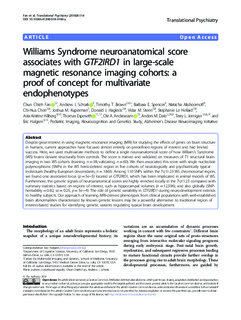| dc.contributor.author | Fan, Chun Chieh | |
| dc.contributor.author | Schork, Andrew J. | |
| dc.contributor.author | Brown, Timothy T. | |
| dc.contributor.author | Spencer, Barbara E. | |
| dc.contributor.author | Akshoomoff, Natacha | |
| dc.contributor.author | Chen, Chi-Hua | |
| dc.contributor.author | Kuperman, Joshua M. | |
| dc.contributor.author | Hagler, Donald J. | |
| dc.contributor.author | Steen, Vidar Martin | |
| dc.contributor.author | Le Hellard, Stephanie | |
| dc.contributor.author | Håberg, Asta | |
| dc.contributor.author | Espeseth, Thomas | |
| dc.contributor.author | Andreassen, Ole Andreas | |
| dc.contributor.author | Dale, Anders | |
| dc.contributor.author | Jernigan, Terry L. | |
| dc.contributor.author | Halgren, Eric | |
| dc.date.accessioned | 2019-04-05T14:47:04Z | |
| dc.date.available | 2019-04-05T14:47:04Z | |
| dc.date.created | 2018-07-13T14:51:32Z | |
| dc.date.issued | 2018 | |
| dc.identifier.citation | Translational psychiatry. 2018, 8:114 (1), 1-8. | nb_NO |
| dc.identifier.issn | 2158-3188 | |
| dc.identifier.uri | http://hdl.handle.net/11250/2593579 | |
| dc.description.abstract | Despite great interest in using magnetic resonance imaging (MRI) for studying the effects of genes on brain structure in humans, current approaches have focused almost entirely on predefined regions of interest and had limited success. Here, we used multivariate methods to define a single neuroanatomical score of how William’s Syndrome (WS) brains deviate structurally from controls. The score is trained and validated on measures of T1 structural brain imaging in two WS cohorts (training, n = 38; validating, n = 60). We then associated this score with single nucleotide polymorphisms (SNPs) in the WS hemi-deleted region in five cohorts of neurologically and psychiatrically typical individuals (healthy European descendants, n = 1863). Among 110 SNPs within the 7q11.23 WS chromosomal region, we found one associated locus (p = 5e–5) located at GTF2IRD1, which has been implicated in animal models of WS. Furthermore, the genetic signals of neuroanatomical scores are highly enriched locally in the 7q11.23 compared with summary statistics based on regions of interest, such as hippocampal volumes (n = 12,596), and also globally (SNP-heritability = 0.82, se = 0.25, p = 5e−4). The role of genetic variability in GTF2IRD1 during neurodevelopment extends to healthy subjects. Our approach of learning MRI-derived phenotypes from clinical populations with well-established brain abnormalities characterized by known genetic lesions may be a powerful alternative to traditional region of interest-based studies for identifying genetic variants regulating typical brain development. | nb_NO |
| dc.language.iso | eng | nb_NO |
| dc.publisher | Springer Nature | nb_NO |
| dc.rights | Navngivelse 4.0 Internasjonal | * |
| dc.rights.uri | http://creativecommons.org/licenses/by/4.0/deed.no | * |
| dc.title | Williams Syndrome neuroanatomical score associates with GTF2IRD1 in large-scale magnetic resonance imaging cohorts: A proof of concept for multivariate endophenotypes | nb_NO |
| dc.type | Journal article | nb_NO |
| dc.type | Peer reviewed | nb_NO |
| dc.description.version | publishedVersion | nb_NO |
| dc.source.pagenumber | 1-8 | nb_NO |
| dc.source.volume | 8:114 | nb_NO |
| dc.source.journal | Translational psychiatry | nb_NO |
| dc.source.issue | 1 | nb_NO |
| dc.identifier.doi | 10.1038/s41398-018-0166-y | |
| dc.identifier.cristin | 1597206 | |
| dc.description.localcode | © The Author(s) 2018. Open Access. This article is licensed under a Creative Commons Attribution 4.0 International License. | nb_NO |
| cristin.unitcode | 194,65,30,0 | |
| cristin.unitname | Institutt for nevromedisin og bevegelsesvitenskap | |
| cristin.ispublished | true | |
| cristin.fulltext | original | |
| cristin.qualitycode | 1 | |

